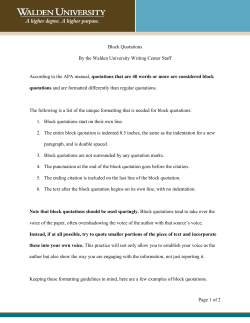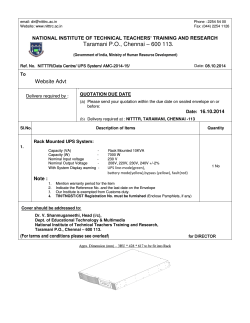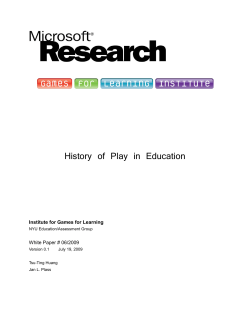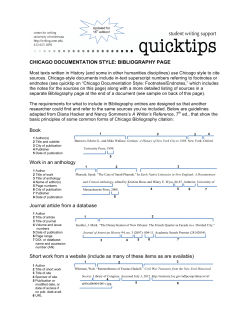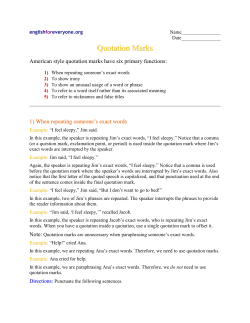
Style sheet for essays
Style sheet for essays How to write a term paper The following guidelines conform to conventions that rest on a broad academic consensus. The concrete style may differ slightly, though it is important to use one system consistently. 1. Layout - Font: Arial, Times New Roman - Font size: 12pt - Line spacing: 1,5 - Center justification - Right margin: 3,5 cm - Left margin: 2,5 cm - Top margin: 2,5 cm - Bottom margin: 2,5 cm - Pagination: do not count the title page; start counting with the table of contents, but only number pages from the introduction on. - Use design elements (bold, italic, underline) sparingly. - Footnotes: 10pt, single spaced, center justification. Annotations (full sentences) and references end with a full stop. - Bibliography: Alphabetic order, single-spaced, blank line between entries, end with a full stop. 2. Structure Formally, a term paper consists of: Title Page, Table of Contents, List of Abbreviations, List of Figures / List of Tables (if necessary), Introduction, Main Body, Conclusion, References / Bibliography, Appendices (if necessary). The text length (Introduction, Main Body and Conclusion) shall not go below and shall not exceed 3500 words (8 – 10 pages) considerably. Title Page - Name of the University and the Institute - Title of the seminar, semester, name of lecturer - Title of your paper - Author, address, telephone, e-mail - Degree course, year/semester, registration number (Matrikelnummer) - Date of delivery UNIVERSITÄT LEIPZIG EMGS Konsortium, Global and European Studies Institute Planning Methods in Peace-building Projects in Africa WS 2010/2011 Prof. Dr. Ulf Engel Title Max Mustermann Musterstraße 1 04277 Musterstadt Max.Mustermann@mustermail.com Master “Global Studies” st 1 year Matrikelnummer: 8901130 Musterstadt, 28.Februar Figure 1. Example Title Page Table of Contents List all headings and subheadings with page numbers. Do not exceed 3 levels (sub-sections). Table of Contents List of Abbreviations…………………………………... i List of Figures / List of Tables…………………….….. ii 1. Introduction………………………………. 3 2. ABC……………………………………….. 4 2.1 aaa……………………………………..…. 5 2.2 bbb………………………………………… 6 2.2.1 bcbc……………………………………….. 6 3. D……………………………………….….. 7 3.1. ddd………………………………………… 8 4. Conclusion……………………………….. 10 References……………………………………………...13 Appendices…………………………………………….. 15 Figure 2. Example Table of Contents Introduction With your introduction, you should give orientation to the reader and make them want to read the rest of the paper. What belongs in the introductory section? - A short description of the issue, a statement of the goal of the paper, questions to be answered, thesis - Placement of specific topic in the broader context - Short overview of current state of research (incl. controversial issues), sources - Explanation of relevance for scientific discourse - Verbal sketch of method and content, guiding the reader to what lies ahead - If necessary, clarification of terms / definitions Main Body; Argumentation and Results After you told the reader what you are going to say, say it. The structure of this part depends on your objective. As such there are no generally binding conventions on how many chapters a term paper needs to have and which aspects need to be considered (presentation, interpretation, discussion). Basically: - The text is divided into sections / subsections, each presenting a main point in the argument or relevant information. Within a chapter, the text is divided in sections that present an argumentative / logic unit. Single sentences are not paragraphs! - Develop your argument step-by-step and in a comprehensible manner. References to common knowledge or personal experience are not sufficient. Avoid verboseness and repetitions. Content / positions from other academic writing must not necessarily be adopted unquestioned. You can quote a certain position and then disprove it or contrast it with your own (well reasoned) opinion (“Contrary to x‟s interpretation, it is reasonable to …, because …”). - All literature used needs a reference. This applies to literal as well as analogous quotation of text, ideas and data (see below). If further comments seem necessary, but would disrupt the fluidity of your text / argumentation, put them in a footnote. - The composition of your text must be clear and logically comprehensible. Each chapter should have a structure. - Depending on your objectives, the following aspects are to be prioritized accordingly: interpretation of primary literature / sources, methodological problems, current state of research, your own standpoint. - Your own standpoint is important. Do not only summarize texts or collect quotations. Give reasons for your ideas, opinions and criticism and weigh them against other positions. - Only give information relevant to the comprehension of your issue. Conclusion - Refer back to the problem posed, and describe the conclusions that you reached from your work, summarize observations and interpretations. - Consider strengths and limitations of your work (fruitfulness of questions, suitability of method, broader implication of your results, perspectives for future research). - Do not repeat word for word the introduction or discussion. - The final chapter should not only give the reader the feeling that it was worthwhile to read your paper, but it should also stimulate further thinking. References / Bibliography Cite all ideas, concepts, text, data that are not your own. All references cited in the text must be listed in your bibliography. This contains written sources, media (photos, videos etc.) and oral sources (interviews). Generally, the references are divided into sources / primary literature and secondary literature. A separation into published, unpublished, electronic, oral (etc.) might be necessary, depending on the subject. Appendices Appendices (maps, statistics, charts …) may make sense to provide more detailed information. However, they should not be used as self-explanatory sources or “decoration”, but must be explained in the body of your text and be relevant to it. Each appendix should have a title in the same format as the heading of a chapter. Each piece of information needs a reference. Tables and figures should be embedded in the text, unless they are more than one page. 3. Style The style of your writing should be precise, comprehensible and objective. A precise use of terms and definition of technical terms are as essential as correct spelling and punctuation. Avoid nested sentences, repetitions and passive constructions. Use footnotes for references and brief annotations (do not write an “extra chapter”). Writing is a process; let other people proofread your text. 4. Scholarliness A term paper shall conform to scientific standards. It is neither a newspaper article or a tale nor a police report. The essential characteristics of scientific writings are: - Support: if you make a statement, back it up with a reference (or your own empirical findings). Exceptions are statements that can be assumed to be common knowledge and your own considerations. - Paraphrasing: ideas and opinions from other texts must be expressed in different words. - Quoting: literally used text passages must be “quoted”. The origin of the quote must be clear (see below). - Justification: reasons must be given for statements, conclusions, methods, literature and sources as well as central questions. - Definition and specification: explain how you understand and use central terms. - Differentiation: consider and present not only one opinion, but more (if not all) other positions. Address controversies. - Plagiarism: ~ is the practice of copying another person‟s ideas, words or work without adequate acknowledgement. It is consider academic fraud and will be judged as such. 5. Citation All quotations (literal and analogous) need a reference. The function of quotations is mainly to back up statements and arguments. Basically, no quotation is meaningful by itself. It must be embedded, explained and interpreted in your context of reasoning. Literal quotation Literal quotations must be declared as such through “quotation marks”. A quotation within a quotation is marked with „single quotation marks‟. “In full sentences, quotation marks stand outside the punctuation.” If only a single word or a group of words is quoted, quotation marks “stand inside the punctuation”. Quotations longer than three lines are separated from the text above and below through a blank line, indented left and right and are written single-spaced. No quotation marks are needed. A quotation within a quotation is marked with “quotation marks”. Quotation marks can also be used for single terms (“scientific”) or to critically distance oneself from certain expressions (“ahistoric people”). Literal quotations are written in the original language. If this language is probably not known to the potential audience, give a translation in a footnote. If the original has orthographic or grammatical mistakes, write [sic] behind the respective word. Additions and annotations are put into square brackets as well. Omissions are marked by […]. Respect the original sense and the grammar of the quotation and of your text. Analogous quotation (paraphrasing) Analogous quotations are thoughts of others formulated in your own words. Mostly expressed using reported speech (starting with X claims, Y states etc.) 6. Annotations, References The function of annotations is - To ensure the verifiability of your statements through exact references. They are necessary for all literal and analogous quotations, quantitative information, all theses and arguments derived from the literature (everything which is not your own). - To present further references, definitions or additional information. These should be brief and clear, no digressions, the main text has to be comprehensible without annotations. 1 Annotations are given in footnotes that are consecutively numbered. If the annotation refers to a 2 single word or group, it follows directly . If it refers to a whole sentence or contextually related 3 sentences, it follows the punctuation/paragraph. References Again: cite all ideas, concepts, text, data that are not your own. All references cited in the text must be listed in your bibliography, each must point clearly to a specific entry in your list. You can either use footnotes or in-text citation (stick to one system). Necessary information and format in both systems: Author, year, page(s). For works by more than three authors write the first author and the abbreviation et al.. Use the abbreviation ibid. for consecutive quotations from the same author(s). Give the exact page(s) you refer to (140, 140-141, 140-150). If you quote a source [that you can not access yourself] from another author‟s work (secondary 4 citation) write cited by. - Footnotes: “The reality of contemporary Africa is that the pragmatically and symbolically instrumental function of 5 politics is critical.” “It is crucial to understand that the foundations of political accountability in Africa are both collective and extra-institutional: they rest on the particularistic links between Big Men 6 […], and their constituent communities.” Or: Politics in contemporary Africa is factional, because “the foundations of political accountability in Africa 7 are both collective and extra-institutional” . The process of „democratization‟ has not resulted in a fundamental modification of political relations 8 between the governing elites and the governed. - In-text citation: 1 2 3 4 Institutions are “sets of constraints on behavior in the form of rules and regulations; a set of procedures to detect deviations from the rules and regulations […]” (Douglas North, cited by Bratton and van de Walle 1997: 40). 5 Chabal and Daloz 1999: 56. 6 Ibid: 37. 7 Chabal and Daloz 1999: 37 8 Ibid: 37-38. “The reality of contemporary Africa is that the pragmatically and symbolically instrumental function of politics is critical” (Chabal and Daloz 1999: 56). Or: The process of „democratization‟ has not resulted in a fundamental modification of political relations between the governing elites and the governed (ibid.: 37-38). Chabal and Daloz (1999: 56) claim … If you refer to websites: Name of the website <URL>, (Day Month Year of access). 7. References / Bibliography List all references cited in the text in alphabetic order using the following format. Refer to the title page (not the cover) for publication details. Give the author and editor‟s surname and first name, but not the academic titles. Specify the edition from the second on (2nd rev.[ised] or suppl.[emented] edition). If author, year or place of publication are not known: anonymous [anon.], no date [n.d.], no place [n.p.]. For different publication by the same author from the same year: Carothers 2006a, Carothers 2006b etc.. Books General format: Author #1 LastName, FirstName(s) and Author #2 FirstName(s) LastName. Year of Publication. Title. Place of Publication: Publisher. Single author Carothers, Thomas. 2006a. Confronting the Weakest Link: Aiding Political Parties in New Democracies. Washington D.C.: Carnegie Endowment for International Peace. Multiple authors Chabal, Patrick and Jean-Pascal Daloz. 1999. Africa Works: Disorder as Political Instrument. Oxford: James Currey. Editor(s) as author(s) Dowding, Keith; Hughes, James and Helene Margetts (eds.). 2001. Challenges to Democracy: Ideas, 9 Involvement and Institutions. The PSA Yearbook 2000. London: Pelgrave. Corporate author Konrad Adenauer Foundation. 2007. Annual Report 2006. Sankt Augustin: Konrad-AdenauerFoundation. Chapters in a book or collection General format: Author LastName, FirstName(s). Year of Publication. “Title”, in: Editor(s) LastName, FirstName(s) (Ed(s.). Title of Book. Title of Series. Place of Publication: Publisher, page numbers. Carothers, Thomas. 2006b. “Examining International Political Party Aid”, in: Burnell, Peter (ed.). Globalising Democracy: Party Politics in Emerging Democracies. Abingdon: Routledge, 69-87. Journal Articles General format: Author LastName, FirstName(s). Year of Publication. “Title”, Title of Journal, Volume/Issue, page numbers. 9 For works by more than three authors write the first author and the abbreviation et al.. Carothers, Thomas. 2002. “The End of the Transition Paradigm”, Journal of Democracy, 13/1, 5-19. Newspaper / Magazine Articles General format: Author LastName, FirstName(s). Year of Publication. “Title”, Title of Newspaper [City of Publication if 10 not in Title] / Magazine, Day Month Year, page numbers. Dissertations and Theses (unpublished) General format: Author LastName, FirstName(s). Year of Publication. “Title”, Kind of Work, University, Place of Publication. Electronic publications General format following applicable rules above: Author LastName, FirstName(s) or Organization. Date of Publication or last update. “Title”. <URL> (Day Month Year of access). Carothers, Thomas. 2004. “Political Party Aid”, Paper prepared for the Swedish International Development Agency. Washington DC: Carnegie Endowment for International Peace. <http://www.idea.int/parties/upload/Political_Party_Aid_by_Carothers_Oct04.pdf> (01.10.2006). National Democratic Institute. 2007. “Kenya”. <http://www.ndi.org/worldwide/safrica/kenya/kenya.asp (20.12.2007). In-text reference “The reality of contemporary Africa is that the pragmatically and symbolically instrumental 11 function of politics is critical.” The process of „democratization‟ has not resulted in a fundamental modification of political relations between the governing elites and the governed (Chabal and Daloz: 37-38). Corresponding bibliography entry Chabal, Patrick and Jean-Pascal Daloz. 1999. Africa Works: Disorder as Political Instrument. Oxford: James Currey. For further information on citation styles see: University of Berkeley Library. 2004. “Citing your sources”. <http://www.lib.berkeley.edu/instruct/guides/citations>. Bedfort College Publisher. 2003. “A Reference Guide to Using Internet Sources”. <http://www.bedfortstmartins.com/online/index.html>. 10 If you cover a longer period: Leipziger Volkszeitung, March 2000-November 2007.
© Copyright 2025


